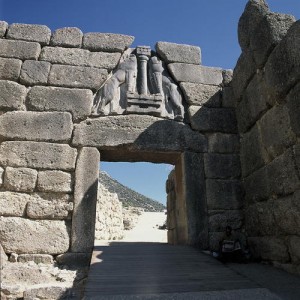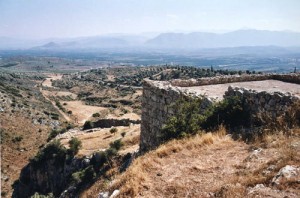Imagine living in a mud brick house in complete poverty and walking past colossal stone ruins every day on your way to the watering hole, in the Mediterranean around 900 BCE the small rural tribes did just that. Seeing these gigantic structures, extremely foreign, and never knowing where they came from strained the small tribes’ understanding to the point where they designed myths to help explain. They believed that the monumental structures were created by a great race before them that had died out. They did not believe humans like themselves had the strength (or technology) to build such massive architecture. This idea is called ethnocentrism and will be explained in greater depth later.
The historical period between 1200 and 900 BCE has been labeled the “Greek Dark Ages” or (more precisely) the Submycenaean Period. After the Mycenaean Palaces fell, because of multiple devastating factors (such as war, bronze drought, water drought, and the destruction of trade routes), civilization thinned out. Without the Palace structure as anchor, the city’s urban center rapidly decentralized and the population settled in small groups, building mud brick houses. The time of monumental architecture was over and, soon, forgotten.
Civilization in the Mediterranean practically started over again. History was lost, writing was lost, and technology was lost. Faced with the ruins of such monumental architecture as the Lion Gate at Mycenae[1] and the “Cyclopean” walls at Tiryns[2] the people of the Submycenaean and Early Geometric Periods came up with a way of understanding that modern archaeologists would call “ethnocentric.”
Ethnocentrism is cultural bias. Ethnocentrism entails judging the practices of another culture using the standards and values of one’s own society. Everyone is susceptible to ethnocentrism; being aware is the only way to fight it.
People of the Submycenaean Period called the time before them the “Heroic Age” because they judged the ruins to be too grand for humans of their day to build. In this case they are being ethnocentric because they judged the race before them to be incapable to build such structures, unless they had superhuman abilities. They attributed the structures to a race before them, a race of heroes and monsters, long extinct. Hence, the gigantic walls at Tiryns were called “Cyclopean” because only a Cyclopes could have lifted bricks so large.
Although most of us do not live in mud brick houses and walk past monumental ruins (if only we did!) on our way to town, ethnocentrism still exists. What we need to understand as a whole is that past cultures were not LESS civilized then our own, nor MORE civilized. We, as archaeologists, need to analyze civilizations using an open mind, logic, and unbiased data.
Further Reading:
Neer, Richard T. Greek Art and Archaeology, A New History, c. 2500-c.150 BCE. Thames & Hudson. New York, New York. 2012.
Fitton, J. Lesley. The Discovery of the Greek Bronze Age. Harvard University Press. Cambridge, MA. 1996.



The key here is, as you rightly point out, that no culture is more or less civilized than another. The Greek Dark Ages, for example, while leaving no impressive ruins for us to marvel at, set the stage for the next “wave” of Greek civilization – the democracy of Athens, the military dominance of Sparta – and had far-reaching consequences that we see even today. Interestingly, Yale University historian Thomas R. Martin, in Ancient Greece (1996), notes that the Greeks of the so-called Dark Ages, though they had lost the writing of the Mycenaeans before them, adapted the Phoenician alphabet “in a fundamental way by introducing vowels as letters. The Greek version of the alphabet eventually formed the base of the alphabet used for English today.” (Martin 43) Even without the grandiose palaces of their predecessors, this civilization, which early archaeologists may have written off as more “primitive” than the Mycenaeans, is every bit as complex, important, and its legacy is just as worthy of study.